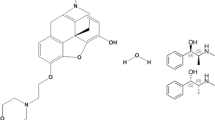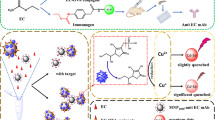Abstract
Ephedrine is one of the main precursor compounds used in the illegal production of amphetamines and related drugs. Actually, conventional analytical methods such as high-performance liquid chromatography (HPLC), capillary electrophoresis (CE), and gas chromatography–mass spectrometry (GC–MS) are used for the detection of ephedrine; sadly, these methods require qualified personnel and are time-consuming and expensive. In order to overcome these problems, in recent years, different methods have been developed based on the surface plasmon resonance (SPR) and electrochemical method. In this work, we present a simple, rapid, and effective method to detect the presence of ephedrine in solution, based on competitive fluorescence resonance energy transfer (FRET) assay. The antibody anti-ephedrine and ephedrine derivative were produced and labeled respectively, with two different fluorescent probes (donor and acceptor). The change in FRET signal intensity between donor and acceptor ephedrine compounds gives the possibility of detecting ephedrine traces of at least 0.81 ± 0.04 ppm (LOD).

A new Time-resolved Fluorescence Resonance Energy Transfer (FRET) assay for ephedrine detection






Similar content being viewed by others
References
Abourashed EA, El-Alfy AT, Khan IA, Walker L. Ephedra in perspective—a current review. Phytother Res. 2003;17:703–12.
Rege B, Carter KM, Sarkar MA, Kellogg GE, Soine WH. Irreversible inhibition of CYP2D6 by (−)-chloroephedrine, a possible impurity in methamphetamine. Drug Metab Dispos. 2002;30:1337–43.
Deventer K, Van Eenoo P, Baele G, Pozo OJ, Van Thuyne W, Delbeke FT. Interpretation of urinary concentrations of pseudoephedrine and its metabolite cathine in relation to doping control. Drug Test Anal. 2009;1:209–13.
Fang H, Liu M, Zeng Z. Solid-phase microextraction coupled with capillary electrophoresis to determine ephedrine derivatives in water and urine using a sol-gel derived butyl methacrylate/silicone fiber. Talanta. 2006;5:979–86.
Deng D, Deng H, Zhang L, Su YJ. Determination of ephedrine and pseudoephedrine by field-amplified sample injection capillary electrophoresis. Chromatogr Sci. 2014;52:357–62.
Drake SJ, Morrison C, Smith F. Simultaneous chiral separation of methylamphetamine and common precursors using gas chromatography/mass spectrometry. Chirality. 2011;23:593–601.
Hu Z, Zou Q, Tian J, Sun L, Zhang ZJ. Simultaneous determination of codeine, ephedrine, guaiphenesin and chlorpheniramine in beagle dog plasma using high performance liquid chromatography coupled with tandem mass spectrometric detection: application to a bioequivalence study. Chromatogr B Anal Technol Biomed Life Sci. 2011;15:3937–42.
Niemann RA, Gay ML. Determination of ephedrine alkaloids and synephrine in dietary supplements by column-switching cation exchange high-performance liquid chromatography with scanning-wavelength ultraviolet and fluorescence detection. J Agric Food Chem. 2003;51:5630–8.
Matapatara W, Thongnopnua P, Lipipun V. Simultaneous detection of amphetamine, methamphetamine and ephedrine by heterology competitive enzyme-linked immunosorbent assay. Asian Biomed. 2007;1:167–79.
Mazzotta E, Picca RA, Malitesta C, Piletsky SA, Piletska EV. Development of a sensor prepared by entrapment of MIP particles in electrosynthesised polymer films for electrochemical detection of ephedrine. Biosens Bioelectron. 2008;28:1152–6.
Varriale A, Staiano M, Marzullo VM, Strianese M, Di Giovanni S, Ruggiero G, et al. A surface plasmon resonance-based biochip to reveal traces of ephedrine. Anal Methods. 2012;4:1940–4.
Di Giovanni S, Varriale A, Marzullo VM, Ruggiero G, Staiano M, Secchi A, et al. Determination of benzyl methyl ketone—a commonly used precursor in amphetamine manufacture. Anal Methods. 2012;4:3558–64.
Jares-Erijman EA, Jovin TM. FRET imaging. Nat Biotechnol. 2003;21:1387.
Haas E, Wilchek M, Katchalski-Katzir E, Steinberg IZ. Distribution of end-to-end distances of oligopeptides in solution as estimated by energy transfer. Proc Natl Acad Sci U S A. 1975;72:1807.
Lakowicz JR, Gryczynski I, Wiczk W, Laczko G, Prendergast FC, Johnson ML. Conformational distributions of melittin in water/methanol mixtures from frequency-domain measurements of nonradiative energy transfer. Biophys Chem. 1990;36:99.
Chapman ER, Alexander K, Vorherr T, Carafoil E, Storm DR. Biochemistry. 1992;31:12819.
Heyduk T. Measuring protein conformational changes by FRET/LRET. Curr Opin Biotechnol. 2002;13:292.
Hink MA, Bisselin T, Visser AJ. Imaging protein-protein interactions in living cells. Plant Mol Biol. 2002;50:871.
Parsons M, Vojnovic B, Ameer-Beg S. Imaging protein–protein interactions in cell motility using fluorescence resonance energy transfer (FRET). Biochem Soc Trans. 2004;32:431.
Bunt G, Wouters FS. Visualization of molecular activities inside living cells with fluorescent labels. Int Rev Cytol. 2004;237:205.
Van Der Meer BW, Coker G, Chen SYS. Resonance energy transfer: theory and data. New York: VCH; 1994.
Lakowicz JR. Principles of fluorescence spectroscopy. 2nd ed. New York: Kluwer; 1999.
Selvin PR. The renaissance of fluorescence resonance energy transfer. Nat Struct Biol. 2000;7:730.
Cheng LT, Kim SY, Chung A, Castro A. Amphetamines: new radioimmunoassay. FEBS Lett. 1973;36:339–42.
Staiano M, Scognamiglio V, Rossi M, D’Auria S, Stepanenko OV, Kuznetsova IM, et al. Unfolding and refolding of the glutamine-binding protein from Escherichia coli and its complex with glutamine induced by guanidine hydrochloride. Biochemistry. 2005;44:5625–33.
Pennacchio A, Ruggiero G, Staiano M, Piccialli G, Oliviero G, Lewkowicz A, et al. A surface plasmon resonance based biochip for the detection of patulin toxin. Opt Mater. 2014;10:1670–5.
De Champdoré M, Bazzicalupo P, De Napoli L, Montesarchio D, Di Fabio G, Cocozza I, et al. A new competitive fluorescence assay for the detection of patulin toxin. Anal Chem. 2007;79:751–7.
Armbruster DA, Pry T. Limit of blank, limit of detection and limit of quantitation. Clin Biochem Rev. 2008;29:49–52.
Acknowledgments
This project is in the framework of the FP7 EU Project “CUSTOM” grant agreement number: 242387 (DS, AV, MS).
Author information
Authors and Affiliations
Corresponding authors
Ethics declarations
Conflict of interest
The authors declare that they have no conflict of interest.
Rights and permissions
About this article
Cite this article
Varriale, A., Marzullo, V.M., Di Giovanni, S. et al. On the possibility of ephedrine detection: time-resolved fluorescence resonance energy transfer (FRET)-based approach. Anal Bioanal Chem 408, 6329–6336 (2016). https://doi.org/10.1007/s00216-016-9738-y
Received:
Accepted:
Published:
Issue Date:
DOI: https://doi.org/10.1007/s00216-016-9738-y




